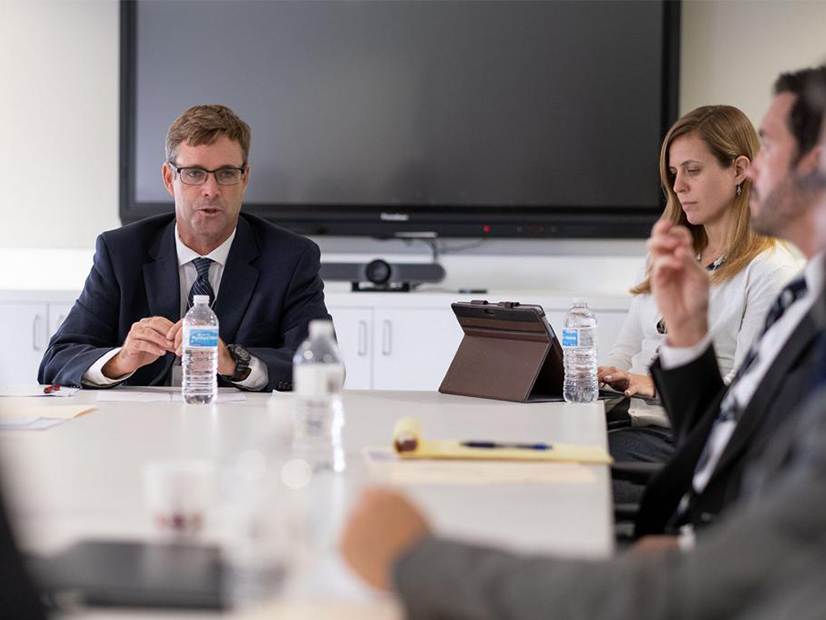Hawaii’s recent move to performance-based regulation (PBR) is still “a work in progress,” state Public Utilities Commission Chair James Griffin told participants at the Smart Electric Power Alliance (SEPA) Grid Evolution Summit last week.
“None of this is easy. I want to be clear: It was contentious,” Griffin said Wednesday. Hawaii switched from cost-of-service regulation to PBR in June, an effort “two-and-a-half years in the making,” with some programs still being implemented.
Hawaii’s PBR framework includes “four big sections,” Griffin said, including revenue adjustment mechanisms, performance incentive mechanisms (PIMs), grid services incentives and a collaborative effort between the PUC and energy efficiency providers to provide programs for low- to moderate- income residents.
Noting Hawaii’s “high electricity cost environment,” Griffin said, “From the outset of this, [the PUC] did want to see Day One savings for customers.”
Moderating the discussion with Griffin, SEPA Managing Director Janet Gail Besser pointed to a key feature of Hawaii’s PIMs: “The focus is on outputs or outcomes for customers to set rates, rather than inputs on the part of the utility — what it costs to serve the customer.”
Griffin said the PUC wants to ensure cost savings by setting a key productivity factor for utility companies at zero. “Our prior experience with this did inform us that this was a sufficient factor to meet our goals.”
But speed is of the essence for the PUC. “The timing aspect of this is really important for us, and I think that’s where we’re still looking for improvement. We’re wanting to see the projects come online sooner. The incentive structure here is front-loaded, but I haven’t quite seen the urgency yet to move the timelines up, so we’re still working on that.”
Griffin referred to the PUC’s contentious proceeding around the looming shutdown of a critical coal plant on Oahu, with the commission repeatedly expressing frustration at Hawaiian Electric’s halting efforts to replace the plant with renewable resources. “Our near-term needs enough replacement resources for when our power plants go offline.” (See Hawaii PUC Weights Coal Plant Closure Options.)
Besser asked Griffin about the PUC’s pilot process for the PBR framework, “because that’s something that SEPA has been encouraging and sees as very important for grid modernization — in particular, how to really expedite the review of pilots so that utilities can get new pilots and new operating practice out there quickly to see if they’re actually going to benefit customers.”
Griffin explained that the commission has 45 days to review a pilot plan once it has been submitted. Investors and developers need to have their “homework done” so that the review process does not become bogged down, he said. “We hope to see more of this in the next five years.”
“This has been a cultural change internal to the commission as well,” Griffin said. “One of my observations is that this is what it’s going to take for this to be successful. What the tradition has been is, we’ve received some pilot applications in the past, but generally they follow through our normal regulatory framework. So, a $1 million request for a short-term pilot would be treated, in our former process, similar to a $400 million dollar [advanced metering infrastructure] request.”
Griffin said the commission can accept that some projects will fail, “and it’s better to learn that and avoid the long, protracted fight over something that you learned, that you shouldn’t be doing. That’s been a cultural discussion internally … We need to allow the utility the flexibility to do these pilots, learn, and even find out where things don’t work out perfectly.”
Griffin pointed to the PUC’s experience with Hawaii Gas. “We had a good case with our gas utility, trying to look at different renewable gas technologies a while ago. And we learned that it wasn’t [commercially viable] yet, and to me, that was a decent learning experience. So, we can see some of this on the electricity side too,” he said.
No Easy Shortcuts
All this change has been noted by crediting agencies, who have since raised their outlook for Hawaiian Electric.
“We weren’t quite on a watch yet, but this docket and these decisions were being closely watched through the entire period,” Griffin said, referring to the utility. “As we worked through the process, we were put on an upgrade watch. The outlook was upgraded.” He said that before the upgrade, the utility was not doing well, with its S&P rating “one notch above junk status.”
Asked what lessons or key takeaways he would share with other states, Griffin said “the incentive mechanisms can be very powerful” and that the PUC is seeing “actual results delivered.”
“Taking the time to set it up right, it’s been a very resource-intensive process for our commission. There’s no easy shortcuts here if you want to do the type of comprehensive review, comprehensive stakeholder engagement that we’ve done … Don’t underestimate the undertaking,” he said
The PUC chair also made clear that the decision to switch from a cost-of-service regulation to a PBR framework was resolute. “It’s something that we see is a strong part of our future. We’re not intending to return back to a traditional cost-of-service regulatory framework, and it was important to signal that from the outset.”



